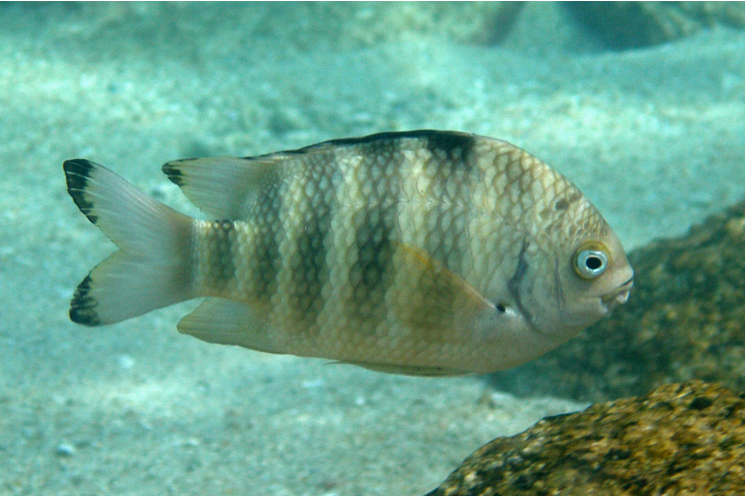- Classification
- ACTINOPTERYGII
- PERCIFORMES
- POMACENTRIDAE
- Abudefduf
- septemfasciatus
Banded Sergeant, Abudefduf septemfasciatus (Cuvier 1830)
Other Names: Narrow-banded Sergeant-major

A Banded Sergeant, Abudefduf septemfasciatus, at Lizard Island, Great Barrier Reef, Queensland. Source: Andy Lewis / Lizard Island Field Guide, http://lifg.australianmuseum.net.au/. License: CC by Attribution-NonCommercial-ShareAlike
Summary:
A whitish (usually) damselfish becoming whitish below, with 6 relatively broad dusky bars from the rear of the head to the tail base, and a small spot at the upper pectoral-fin base. The bands are wider than the pale interspaces. Individuals may also have dark fin margins.
Cite this page as:
Bray, D.J. 2025, Abudefduf septemfasciatus in Fishes of Australia, accessed 01 Jul 2025, https://fishesofaustralia.net.au/Home/species/307
Banded Sergeant, Abudefduf septemfasciatus (Cuvier 1830)
More Info
|
Distribution |
Shark Bay, Ashmore Reef and Cartier Island in the Timor Sea, around the tropical north to Tweed Heads, northern New South Wales, including reefs in the Coral Sea - with juveniles south to at least Arrawarra Headland, New South Wales; also Christmas Island and Cocos (Keeling) Islands in the eastern Indian Ocean, and Norfolk Island in the Tasman Sea. Elsewhere the species occurs in the tropical, Indo-west-central Pacific. Inhabits shallow areas exposed to mild or moderate surge in lagoons and on outer reefs. |
|
Features |
Dorsal fin XIII, 12-14; Anal fin II, 11-13; Pectoral fin 17-19; Gill rakers 20-26; Lateral-line scales 20-22. Body depth 1.7–1.9 in SL. |
|
Colour |
|
|
Feeding |
Feeds on algae, benthic invertebrates and zooplankton. |
|
Etymology |
The specific name is from the Latin septem (= seven) and fasciatus (= banded), in reference to the dark vertical bars on the head and body (including one across the top of the head). |
|
Species Citation |
Glyphisodon septemfasciatus Cuvier, 1830, Hist. Nat. Poissons 5: 463. Type locality: Mauritius (as Isle de France). |
|
Author |
Bray, D.J. 2025 |
|
Resources |
Banded Sergeant, Abudefduf septemfasciatus (Cuvier 1830)
References
Allen, G. R. 1986. Family 219: Pomacentridae. pp. 670-682 in Smith, M.M. & Heemstra, P.C. (eds). Smith's Sea Fishes. Johannesburg : Macmillan South Africa xx + 1047 pp. 144 pls.
Allen, G.R. 1991. Damselfishes of the World. Melle, Germany : Mergus Verlag 271 pp.
Allen, G.R. 1993. Fishes of Ashmore Reef and Cartier Island. Records of the Western Australian Museum, Supplement 44: 67-91
Allen, G.R. 1997. Marine Fishes of Tropical Australia and South-east Asia. Perth : Western Australian Museum 292 pp. 106 pls.
Allen, G. R. 2001. Family Pomacentridae. pp. in Carpenter, K.E. & Niem, T.H. (eds). The Living Marine Resources of the Western Central Pacific. FAO Species Identification Guide for Fisheries Purposes. Rome : FAO Vol. 6 pp. 3381-4218.
Allen, G.R. & Erdmann, M.V. 2012. Reef fishes of the East Indies. Perth : Tropical Reef Research 3 vols, 1260 pp.
Allen, G.R., Steene, R.C. & Orchard, M. 2007. Fishes of Christmas Island. Christmas Island : Christmas Island Natural History Association 2 edn, 284 pp.
Allen, G.R. & Smith-Vaniz, W.F. 1994. Fishes of Cocos (Keeling) Islands. Atoll Research Bulletin 412: 1-21.
Allen, G.R. & Swainston, R. 1988. The Marine Fishes of North-Western Australia. A field guide for anglers and divers. Perth, WA : Western Australian Museum vi 201 pp., 70 pls.
Cuvier, G.L. in Cuvier, G.L. & Valenciennes, A. 1830. Histoire Naturelle des Poissons. Paris : Levrault Vol. 5 499 pp. pls 100-140. See ref at BHL
Grant, E.M. 1975. Guide to Fishes. Brisbane : Queensland Government, Co-ordinator General’s Department 640 pp.
Hobbs, J-P.A., Newman, S.J., Mitsopoulos, G.E.A., Travers, M.J., Skepper, C.L., Gilligan, J.J., Allen, G.R., Choat, H.J. & Ayling, A.M. 2014. Checklist and new records of Christmas Island fishes: the influence of isolation, biogeography and habitat availability on species abundance and community composition. Raffles Bulletin of Zoology Supplement 30: 184–202.
Hobbs, J-P.A., Newman, S .J., Mitsopoulos, G.E.A., Travers, M.J., Skepper, C.L., Gilligan, J.J., Allen, G.R., Choat, H.J. & Ayling, A.M. 2014. Fishes of the Cocos (Keeling) Islands: new records, community composition and biogeographic significance. Raffles Bulletin of Zoology Supplement 30: 203–219.
Hsu, L.-L., Borsa, P. & Chen, W.J. 2025. Successive cycles of allopatric differentiation and secondary contact shape phylogeographical structure in an Indo-West Pacific reef fish, Biological Journal of the Linnean Society 144(2): blaf002, https://doi.org/10.1093/biolinnean/blaf002
Hutchins, J.B. 2001. Biodiversity of shallow reef fish assemblages in Western Australia using a rapid censusing technique. Records of the Western Australian Museum 20: 247-270.
Jenkins, A., Carpenter, K.E., Allen, G. & Yeeting, B. 2017. Abudefduf septemfasciatus. The IUCN Red List of Threatened Species 2017: e.T188453A1877191. https://dx.doi.org/10.2305/IUCN.UK.2017-2.RLTS.T188453A1877191.en. Accessed on 17 June 2025.
Randall, J.E. 2005. Reef and shore fishes of the South Pacific. New Caledonia to Tahiti and the Pitcairn Islands. Honolulu : University of Hawaii Press 707 pp.
Randall, J.E., Allen, G.R. & Steene, R. 1990. Fishes of the Great Barrier Reef and Coral Sea. Bathurst : Crawford House Press 507 pp. figs.
Randall, J.E., Allen, G.R. & Steene, R. 1997. Fishes of the Great Barrier Reef and Coral Sea. Bathurst : Crawford House Press 557 pp. figs.
West, K.M., Stat, M., Harvey, E.S., et al. 2020. eDNA metabarcoding survey reveals fine-scale coral reef community variation across a remote, tropical island ecosystem. Molecular Ecology 29:1069-1086 https://doi.org/10.1111/mec.15382




